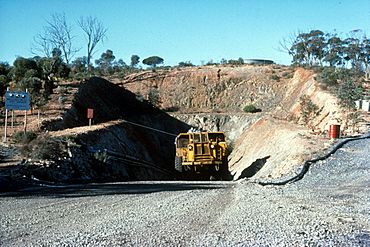Kanowna, Western Australia facts for kids
Quick facts for kids KanownaWestern Australia |
|
|---|---|

The Silver Swan Nickel Mine, north-east of Kanowna, in 2003
|
|
| Established | 1894 |
| Postcode(s) | 6431 |
| Elevation | 377 m (1,237 ft) |
| Area | [convert: needs a number] |
| Location |
|
| LGA(s) | Kalgoorlie-Boulder |
| State electorate(s) | Kalgoorlie |
| Federal Division(s) | O'Connor |
Kanowna is a fascinating ghost town located in the Goldfields area of Western Australia. It's about 20 kilometres (12 miles) east of Kalgoorlie. A ghost town is a place that used to be busy but is now mostly empty. In 2016, only 10 people lived in Kanowna.
Contents
Kanowna's Gold Rush History
Kanowna became a town because of a big discovery. In 1893, gold was found in the area. This news brought many people hoping to get rich.
The Town's Early Days
The town of Kanowna was officially created in 1894. Its population grew very quickly. By 1897, about 2,500 people lived there. Just two years later, in 1899, the population had jumped to over 12,500!
Why Kanowna Became a Ghost Town
The gold rush didn't last forever. The easy-to-find gold, called alluvial gold, ran out quickly. Miners then tried to dig deeper for gold veins underground. However, these mines produced less and less gold over time. Because of this, people slowly started to leave Kanowna.
During the Great Depression, a tough economic time, the local railway station closed. By 1953, almost everyone had left, and Kanowna became a ghost town. Today, you can still see a few things left from the old town. These include the railway station platform, two cemeteries, and some old mine workings. Signs put up by the Eastern Goldfields Historical Society help visitors find where important buildings used to stand.
Gold Mining Returns to Kanowna
Even though Kanowna became a ghost town, its story wasn't completely over.
New Discoveries and Modern Mining
In the late 1970s, gold prices started to go up. This made people interested in looking for gold in the area again. Geologists (scientists who study rocks) explored the land. They found a large amount of gold that had been hidden deep underground. This gold was not found before because the gold veins didn't reach the surface. This new discovery made gold mining in Kanowna profitable again.
Mining restarted in 1986. At first, miners used open-cut mining, which means digging a large pit from the surface. Later, they moved to underground mines again. By 2002, a mine called the Kanowna Belle mine employed more than 300 people. This shows how important gold mining still is to the region.

